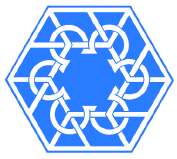What does the Spanda logo stand for?



The Spanda’s logo stands for the interwoven balanced interplaying of the active and passive energies (angles and curves, masculine and feminine, etc.) inscribed into a stable yet highly dynamic regular hexagonal-shaped frame. A hexagon is a polygon with six edges and six vertices, which stands for action. Six is also the direction of space – a symbol of our life in this world, where the cube of six sides is the typical shape of any existential object.
Like squares and equilateral triangles, regular hexagons fit together without any gaps to tile the plane (three hexagons meeting at every vertex), and so are useful for constructing tessellations*. The cells of a beehive honeycomb are hexagonal for this reason, and because the shape makes efficient use of space and building materials.



*Â Tessellate (verb), tessellation (noun): from Latin tessera “a square tablet” or “a die used for gambling.” Latin tessera may have been borrowed from Greek tessares, meaning “four,” since a square tile has four sides. The diminutive of tessera was tessella, a small, square piece of stone or a cubical tile used in mosaics. Since a mosaic extends over a given area without leaving any region uncovered, the meaning of the word tessellate is to cover the plane with a pattern in such a way as to leave no region uncovered. By extension, space or hyperspace may also be tessellated, as may Spanda’s activities.
